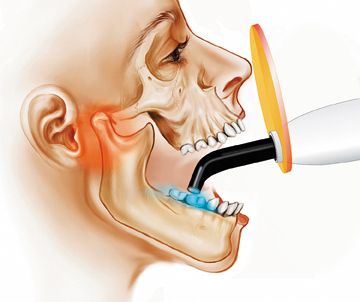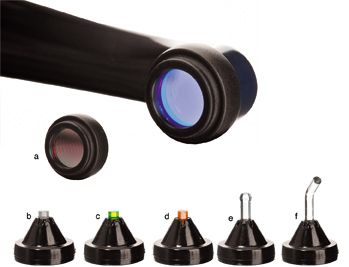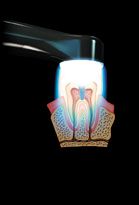Are you sure about your cure?
How Ultradent Products Inc.’s VALO cordless curing light satisfies the criteria necessary for today’s clinicians.
How Ultradent Products Inc.’s VALO cordless curing light satisfies the criteria necessary for today’s clinicians.
All of us use our curing lights daily. Without the magic of these futuristic wands, our restorative practices would cease to exist in a contemporary fashion.
Still, despite this indisputable dependence on our curing lights, their function and characteristics are often an oversight in most of our practices.
These devices cannot be the weak link in restorative delivery. Light cured dental materials like adhesives, resins, modified resins and resin cements are constantly evolving, and the burden of curing these materials continues to increase, particularly with the move toward “bulk fill” and more “opaque substrates” (monolithic zirconia).
We can no longer take our curing lights for granted and assume that the light initiated conversions we count on for longevity, comfort, function and overall success of our restorations are occurring just because we see a “blue light” beaming from the guide.
When speaking to audiences, the focuses of my restorative seminars often revolve around materials and delivery techniques. However, during the Q&A, more and more clinicians ask me about curing lights- “which one do you use and why?” My answer for the past year has been the cordless VALO from Ultradent Products Inc..
Following is my estimation of the most important features of a curing light and how the VALO satisfies the criteria.
Curing function. How effective is the light in predictably curing the largest variety of light initiated restorative products? This is an important point that is often overlooked by practitioners. The majority of adhesives and resins are manufactured to curing specifications that fall within a common wavelength range.
However, this is not the case for all products. Clinicians, who do their research and are aware of any atypical specifications for a given product, may find themselves unable to switch to a desired product based on the limitations of their lights. The alternate scenario is far more catastrophic. That is, when a product change is made and incomplete cure occurs routinely (generally undetectably).
One can imagine the fall out that has to be addressed when patients begin to present with premature failures. The cost of such an error, especially when protracted over a long period of time, can have a devastating impact on the good will, economics and productivity of a practice relegated to “re-treatment” mode.
VALO contains four LEDs. Three of which are in the blue light range targeting camphorquinone, the molecule that serves as the photo-initiator for the majority of resins. The fourth LED is in the green (though I know green views this light best, we characterize the 390-405 nm output range as “violet”) light range and targets polymeric amines that are found in some adhesive resins.
These less prevalent photo-initiators tend to aid in the color stability of their respective products and are often found in more translucent materials. In other words, the combination of LEDs engineered in the VALO will ensure the cure of the entire range of dental products, providing invaluable peace of mind.
Check out this video featuring the VALO curing light and Ultradent's Edelweiss composite veneer system
Durability. The cordless VALO curing light is a sealed unit with a sapphire-like hard surface and a scratch resistant glass lens. The result is a product that is virtually indestructible. We have all experienced the occasional anxiety rush when our curing lights have slipped off the counter or from our hands and crashed to the operatory floor. If there’s no obvious break, we anxiously turn on the light hoping to see the familiar blue beam, avoiding a costly replacement.
While lights slamming to the floor are an infrequent occurrence, I have the added experience of teaching at the University of Pacific, School of Dentistry. Over the years, our clinics have equipped a variety of lights. Between some 150 faculty, 500 students and a large sterilization and dispensary staff, not a week goes by where the familiar crash of a curing light hitting the tile floor is not heard.
The VALO simply holds up under the harshest work conditions. Not only do these lights survive all the drops, the sealed body and surface protection hold up to the common surface sterilizers and disinfectants.
Form and footprint. The flat or toothbrush design of the VALO is a real advantage for the clinician and the patient. We have all experienced restoring the tough to reach the molar of a patient with a limited opening where the combination of the angle and length of the light guide, the pistol style design and the opposing arch of teeth dramatically limit light delivery to the object tooth (Fig. 1). Even a distant 3rd molar or deep cervical aspect of any tooth is easily reached with the VALO.

Fig. 1 The design of other lights limits light delivery.
Reaching the object tooth is half the battle. Effective and efficient curing then comes down to footprint and light columniation. Most competitors’ light guides average 8 mm in diameter and are round. VALO provides a curing footprint that covers the entire surface of a MOD restoration on a large molar or the entire inciso-gingival span of an anterior tooth relevant to veneer delivery. Figs. 2-4 demonstrate the footprint and columniation beam of the VALO versus competitors.



Figs. 2-4 Footprint and columniation beam of the VALO versus competitors.
Versatility. Whenever I consider an investment in technology, I ask 3 questions: How will it improve patient care? Will it perform equal or better than existing technology while increasing efficiency and speed? Can it serve multiple purposes?
The answer is a resounding “yes” with the cordless VALO.
For treatment outcomes, the single most important factor to adhesive resin success beyond the bonding application is maximizing cure. Inadequate cure results in a host of issues the least of which include post-operative sensitivity and recurrent decay at proximal cavosurfaces. The VALO functions in 3 different power modes, Standard (1000mW/cm2), High Power (1400mW/cm2) and Xtra power (3200mW/cm2 – approximating plasma arc function).
In Standard mode, cure cycles can be selected from 5-10-15-20 seconds. This is comparable to standard LED function. A simple toggle of the single programming button allows elevation to the High Power mode where 1-2-3-4 second cycles can be selected.
Finally, in the Xtra Power mode, a single 3-second cycle is available. Built in safety function ensures auto turn off once the maximum curing time in higher power settings are achieved and a mandatory minimal delay is built in at the highest power to ensure temperature recovery of pulpal and soft tissues. In other words, the VALO allows the doctor to maximize cure intensity and minimize time without compromising safety.
This range in selectable performance affords great versatility for all practitioners. Weather the task at hand is traditional incremental placement and curing of composite, bulk filling to depths of 8 mm (per some material specs), curing of resin cements through ceramic substrates, rapid adhesion of orthodontic brackets or even the acceleration of chairside bleaching materials.
In addition to the expanded functionality of the VALO, a host of interchangeable tip additions make it serve a number of functions that ordinarily require other product or technology purchases (Fig. 5).

Fig. 5 The various VALO lenses.
These include a Black Light lens used to detect difficult to visualize resin restorations during removal; PointCure lens used to tack cure ceramic veneers or partial coverage restorations for stabilization prior to cement cleanup; TransLume green and orange lenses, which enable visualization of cracks or undetectable inclusions within the tooth; ProxiCure Ball lens, which aids in contact formation at the matrix interface when placing Class II composite restorations; and EndoGuide lens, which allows for better visualization in tight diameter areas like canal orifices or apical procedures.

Fig. 6 A pleasure to show off to patients.
When function, durability, versatility and overall utility are considered, the cordless VALO LED is, in my opinion, one of the best products on the market. Its compact and lightweight frame and second set of rechargeable lithium batteries allow for trouble-free function for up to 2 weeks at a time with each full charge (typical practice usage). Couple this with its clean lines and futuristic look, and the VALO is a pleasure to show off in front of patients (Fig. 6).
About the author
Dr. Hakim has balanced private practice and dental education for more than 21 years in the San Francisco Bay area. He has a passion for restorative dentistry ranging from complex rehabilitation to optimal and conservative single-tooth restoration. He is Vice Chair of the Department of Restorative Dentistry at the University of the Pacific, course director for “Occlusion, TMJ & Advanced Restorative Concepts” and a director in the “Esthetic and Complex Care Clinic.” Dr. Hakim has lectured nationally in many venues on topics ranging from technology, esthetic dentistry, occlusion, smile design, CAD/CAM, photography and adhesive and composite dentistry. He authored two chapters in the 2010 text, “Esthetic Dentistry in Clinical Practice” from Blackwell Publishing.
ACTIVA BioACTIVE Bulk Flow Marks Pulpdent’s First Major Product Release in 4 Years
December 12th 2024Next-generation bulk-fill dental restorative raises the standard of care for bulk-fill procedures by providing natural remineralization support, while also overcoming current bulk-fill limitations.

